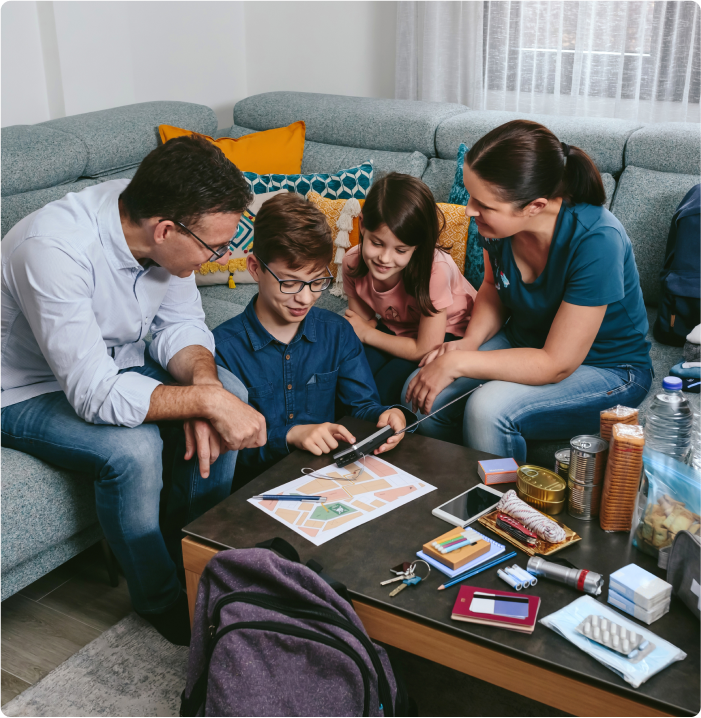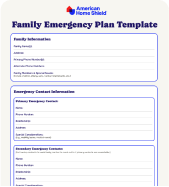Why every family needs a home emergency plan
No one wants to imagine the possibility of a disaster striking their home, it’s a real possibility. From severe weather and unexpected power outages to home fires and exposure to hazardous materials, various emergencies can strike a household without warning. Family emergency planning can make all the difference between chaos and calm in these instances.
A home emergency plan prepares you for the worst while also providing a road map for all the what-ifs. A good plan outlines how your family will stay connected if separated, where you’ll go in an evacuation, and how to keep essentials like food, water, and medical supplies within reach. Let’s explore what a family disaster plan should include.
1. Assess risks and identify potential emergencies
While there are an almost infinite number of potential emergency scenarios, the truth is that there are some risks more relevant to your household than others. Preparing for every possible scenario may be overwhelming, but identifying the specific emergencies most likely to affect your family is a great place to start.
2. Research local natural disasters
Start by assessing the natural disasters that commonly affect your area. If you live along a coastline, hurricanes or flooding may be top concerns. Tornadoes are frequent in some parts of the country, while earthquakes are a major risk in others.
Use the Federal Emergency Management Agency (FEMA)’s National Risk Index map to view flood maps, wildfire risks, earthquake fault lines, and more across different parts of the country. Other resources include the U.S. Geological Survey (USGS), which has a Landslide Hazard map that allows you to check landslide risk and The American Red Cross’ natural disasters preparedness map also allows you to view natural disasters most likely to affect your area.
3. Consider your home’s unique vulnerabilities
You know your home best, so it’s important to consider the potential hazards within your own home when family emergency planning. For instance, older homes may have outdated electrical systems that are more prone to outages, while homes in heavily forested areas could be at higher risk for wildfires. Important factors to consider when assessing risks include your home’s construction, location, and age when assessing risks. Take note of:
- The structural integrity of foundations, walls, and roofs
- Your approach to drainage and flood protection (gutters, sump pump, landscaping decisions)
- Whether your home is built to be fire resistant (roof and siding material, working smoke and carbon monoxide detectors)
- The functionality and safety of electricity and gas lines
Evaluate personal and family-specific needs
Take into account any special requirements for your household, such as medical needs, pet care, or young children. Are there medications you need to make sure to bring with you in the event you need to leave the house? Do any family members have mobility challenges that might require special assistance or equipment during an evacuation? Having a clear picture of these needs helps you create a plan that’s customized to protect everyone in your home.
Keeping knowledge of probable emergencies in your area, home, and family in mind ensures that your home disaster plan is specific and thorough.
Build your emergency communication plan
In an emergency, staying connected with family members is essential. Depending on the emergency, they may not always be a call or text away, and it can be easy to get separated. Here’s how to create a well-thought out communication plan that works for you and your family.
Identify safe meeting points
Choose two meeting spots — one near your home and one outside your immediate neighborhood. The first can be a nearby park or a neighbor’s house, while the second could be a landmark in your town or a relative’s home in a nearby city. Having multiple options makes sure your family knows where to meet, even if certain areas are unsafe or inaccessible.
Create an emergency contact list
List emergency contacts for each family member, including neighbors, friends, or relatives who can help in an emergency. Make sure each family member has a copy of this list and knows who to call if they’re separated. Add local emergency numbers for quick access to services like police, fire, and medical aid.
Create a home safety supplies and essentials checklist
A well-stocked safety and supplies kit is key to your safety preparedness plan. This kit functions as your “grab-and-go” bag or your home’s emergency station — something with essentials that can help sustain your family if you’re without basic services or need to evacuate quickly. Here are some ideas to get started:
- Basic Essentials: Bottled water, non-perishable food items, a manual can opener, basic cooking supplies if possible.
- First Aid and Medications: A complete first aid kit with bandages, antiseptics, and other basic medical supplies; prescription medications; allergy medications; over-the-counter pain relievers or fever reducers.
- Personal Needs: Infants: diapers, formula, baby food; Pets: food, water, leashes, waste bags; Hygiene supplies: wipes, sanitizer, feminine hygiene products.
- Tools and Safety Gear: A flashlight with extra batteries, a multi-tool, a whistle (for signaling), a small fire extinguisher, local maps, thermal blankets, waterproof matches, a battery-powered or hand-crank radio.
- Copies of Important Documents: Copies of personal identification, insurance policies, and other crucial documents in a waterproof folder.
- Cash and Keys: Cash in small bills for essential purchases, a spare set of house and car keys for easy access if needed.
Keep this kit in an easily accessible location, ideally somewhere everyone in the family knows. Regularly check expiration dates on items like food, water, and medications, and rotate them out as needed to keep your kit current.
Practice and update your plan regularly
A family emergency plan is only effective if everyone knows what to do. Just like a fire drill, running through your emergency plan a few times a year makes sure that each family member feels prepared and comfortable with their role in a crisis. Practice different kinds of emergency scenarios, make sure that every family member knows the communication plan, and check and refresh the supplies in your kit as needed.




